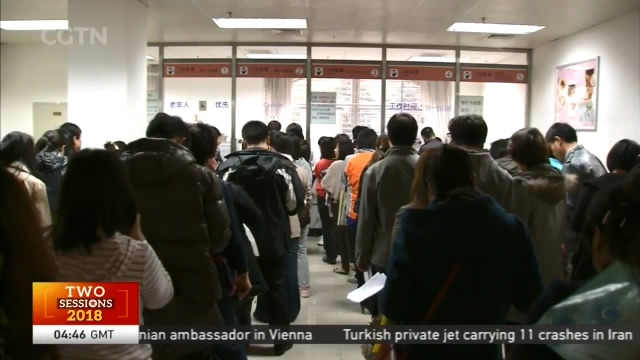
14:08, 12-Mar-2018
Healthcare Reforms: Interprovincial on-the-spot settlement of medical bills to be expanded

Interprovincial on-the-spot settlement of medical bills is seen as an important part of China's ongoing medical reform this year. It is also an indispensable part of implementing the Health China strategy and improving people's livelihood. We take a look at how China's healthcare system has changed over the past few years and what more has to be done.
Chen Yaozhen is from south China's Hainan Province. After retirement, she moved to Guangzhou, the capital city of the neighboring Guangdong Province.
In the past, it would take up to three months for her medical bills to be reimbursed by Hainan authorities.
But the system of interprovincial on-the-spot settlement of medical bills has made this process easier. Now, she can get most of her fees just five minutes after leaving the hospital in Guangzhou.
CHEN YAOZHEN PATIENT IN GUANGZHOU ZHUJIANG HOSPITAL "If I submit medical claims back to Hainan, I need to hand over a lot of certificates and papers. That is troublesome."
In the past few decades, China adopted what was called a local insurance management. It meant that one's insurance was covered and regulated by their home province, or the one they were working in.
But China's fast urbanization process has led to large outflows of populations to other cities and provinces, making it inconvenient for many to obtain their medical reimbursement.
Thus, the concept of the interprovincial on-the-spot settlement was born.
TANG JISONG DIRECTOR, SOCIAL INSURANCE MANAGEMENT MINISTRY OF HUMAN RESOURCES AND SOCIAL SECURITY "No matter whether you are employed or not, live in an urban or rural area, as long as you have basic medical insurance, and go through the proper procedures, you can enjoy interprovincial on-the-spot settlement of your hospitalization fees."
In this year's government work report, Premier Li Keqiang called for the implementation of the Health China strategy. Authorities are set to expand the coverage of interprovincial on-the-spot settlement of medical bills.
A new system was actually proposed back in 2009, and the initial plan was to integrate the urban and rural medical insurance system.
The idea was further discussed in 2014 during China's political season. And by the end of 2016, 30 provinces had realized provincial on-the-spot settlement -- meaning residents could claim their medical insurance in any city within their home province.
2017 witnessed huge progress with the interprovincial on-the-spot settlement. That meant residents need not go back or submit claims to their home province. Over 7,000 medical institutions -- or some 88 percent of large hospitals in China were involved in this plan.
This year, the health authority is aiming to expand this system across community-level hospitals to benefit a larger population and ease the pressure on big hospitals.
A full and well-rounded implementation of this system still faces challenges. The country still has to consider its huge population and varying levels of medical care management in different regions. More work, support, and an advanced network are needed to transition from the long-established local management with this potentially life-changing interprovincial one.

SITEMAP
Copyright © 2018 CGTN. Beijing ICP prepared NO.16065310-3
Copyright © 2018 CGTN. Beijing ICP prepared NO.16065310-3